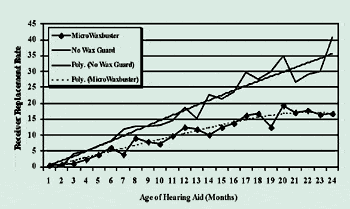The key to success in a dispensing business/practice is to both meet and exceed patient expectations in a timely and cost efficient manner. Digital hearing instrument technology and fitting software hold great promise in delivering real benefits to meet patient needs and provide improved patient satisfaction. Today, the choice of digital features and technology has never been greater; however, studies have shown that the purchases of hearing instruments among consumers who could benefit from them remains about the same as a decade ago.
Only about 22.2% of the people who could use hearing aids actually have the devices.1 Similar studies2 support this statistic: even though 90% of all people with hearing loss can be helped with hearing instruments, fewer than 5% of those who could benefit from them use them.
Dispensing professionals who appropriately select and apply the features of digital instruments to meet the needs of their patients should have satisfied and successful patients who do not need to return for multiple visits. This allows dispensers to see more patients in their practices and potentially reduces the number of people dealing with untreated hearing loss.
Over the last 9 months, the audiologists in our practice have conducted a field trial of the Canta 7 and Canta 4 devices. Case studies of four patients, ranging from new users to experienced wearers of advanced programmable and digital hearing aids, and how the instruments were implemented in specific applications are detailed below. The flexibility of the Canta hearing aids and Aventa fitting software have allowed us to match hearing instrument benefits with patient needs.
The DSP Instruments
The Canta 7 uses a fast fourier transform (FFT) software-based processor and overlapping 14-band digital cochlear dynamics amplification strategy. The device also features spectral enhancement, choices of fast and slow acting digital feedback suppression, active microphone matching, and adaptive directionality. The adaptive directionality is designed to ensure that the optimal polar pattern is in use in a particular setting by constantly adjusting the null point of the directional pattern. Up to four custom listening programs can be activated by the user with a push button on the BTE, ITE, half-shell and ITC hearing aids.
The Canta 4 offers 14-band digital cochlear dynamics, fast acting mild noise reduction (-5 dB), digital feedback suppression, and fixed hypercardioid directionality. Although the Canta 4 series has fewer digital features compared to the Canta 7, the price of the Canta 4 is lower. Its features can be implemented in up to three user-selected programs.
The Aventa software for programming these instruments was developed to combine the features of the ReSource software and Danavox Danafit software. The dispensing professional selects one manufacturer and fitting-software platform. When used consistently, this allows for efficient and effective programming and application of digital technology.
Case Studies
Case 1, RJ: RJ is the owner of a large accounting firm. He needs to be able to hear accurately in a wide variety of settings, from a quiet conference room to business luncheons to the telephone. RJ originally had been fit with WDRC programmable ITE instruments with a remote control. When he was fit with these instruments 5 years ago, he reported that they represented a significant improvement over his previous conventional hearing aids. However, he has consistently struggled with feedback since then, and came to accept difficulty understanding speech in noisy environments.
RJ was fit with full-shell Canta 750-D instruments to address the complaints of hearing in noise and feedback. Utilizing the Madsen Auricle real ear system, probe microphone measurements were obtained with a broadband speech-weighted noise presented at a 45 dB level. Noise reduction in the Canta 750-D was de-activated to allow accurate insertion gain measurements (Table 1).
| Table 1: Subject RJ (Case 1) | ||||||||||||||||||||||||||||||||
|
After several days using the hearing instruments, RJ reported a noticeable improvement in his ability to hear and understand speech in a noisy environment with the use of adaptive directional microphones. He can now change programs for different listening environments without a remote control. Fast acting digital feedback suppression allowed additional gain for soft speech in quiet environments, and a more comfortable fit with no feedback compared to his previous analog programmable instruments. An unexpected benefit was the independently programmable telephone program. The telecoil provided additional assistance in the use of the phone at work and at home.
Case 2, ED: ED is a young business executive with an asymmetric, mixed hearing loss who has never worn hearing aids. He has attempted to get by with his good ear, but reports increasing difficulty understanding speech at work and at home (Table 2).
| Table 2: Subject ED (Case 2) | ||||||||||||||||||||||||||||||||||||||||||||||||||||||||||||||||||||||||||||||||
|
Understanding speech in meetings and on the telephone are important needs for him at work. He is also concerned about wearing hearing instruments that are too visible, but the degree of hearing loss in the poor ear makes it difficult to prescribe a CIC or canal hearing instrument. The Canta 780-D power instrument with a canal lock earmold is a cosmetically acceptable solution to the hearing loss in the poor ear. The instrument is flexible enough that it can be programmed to accommodate the mild hearing loss in the better ear, providing ED with a binaural fitting.
Using the Aventa first-time user algorithm, ED was able to gradually adapt to the use of amplification. He wears the instruments on a full-time basis at work and is pleased with the ease in which he can select programs for quiet meetings, the telephone, and noisy lunch appointments with clients. The volume control on the 780-D also allows him to increase the volume as needed in meetings.
Although he was concerned about how others would perceive his use of hearing aids, ED has been pleasantly surprised at the support of his co-workers. Now that he has taken the step to hear better, he has also learned just how many people knew about his “hidden” hearing problem.
Case 3, YS: YS is an active elderly woman with poor word recognition ability and declining dexterity. The benefit from her previous instruments was reduced by feedback caused by a loose-fitting earmold. However, a tighter fitting earmold is difficult for her to insert properly.
She was fit with Canta 770-D instruments; the earmolds were modified to allow her to insert them properly, and then the feedback calibration procedure was carried out. After feedback calibration, the software displays a maximum stable gain curve (MSG) to indicate which frequency regions contribute to feedback from the instruments. Appropriate gain could be applied to her hearing loss without acoustic feedback by activating fast acting feedback suppression. In addition to providing appropriate gain to maximize audibility, spectral enhancement was activated to optimize clarity and speech intelligibility in a quiet setting. Spectral enhancement is designed to enhance the contrast between consonant and vowel sounds in the speech spectrum without increasing overall gain.
Despite her limited dexterity, YS was able to activate the adaptive directional microphone program. The improvement in signal-to-noise ratio (SNR) with adaptive directionality enabled her to obtain additional benefit in the moderately noise settings she encountered in her community activities and with her family
Case 4, SC: SC is a retired gentleman who used a 4-year-old, first generation, 2-channel digital canal instrument. Since his retirement, SC is more active socially, and he wants to hear well in a greater variety of noisy situations. Financially, he is unable to afford a binaural fitting with premium digital instruments. Therefore, he was fit with binaural Canta 440-D half-shell instruments that better accommodated his financial needs. Although the instruments were less expensive than premium digital hearing aids, SC was able to obtain significant communication benefit as indicated in Table 3.
| Table 3: Subject SC (Case 4) | ||||||||||||||||
|
After several weeks with the instruments, both SC and his wife reported a noticeable improvement in his ability to follow conversation in quiet and in the presence of background noise. In addition to his ability to participate in a variety of situations with more confidence, SC reports that he is pleased with his ability to hear on the telephone with the t-coil program activated. The previous hearing aid did not have a telephone coil, and he usually let his wife handle phone calls with his family. The lower-cost digital instruments allowed him to do well on the telephone, as well as understand speech in quiet and noisy settings.
Summary
Digital instruments like the Canta series provide tools for the dispensing professional to meet the various, individual needs of hearing impaired patients. These needs—including unique hearing loss configurations, cosmetic concerns, and financial and dexterity issues—are all important considerations that can make a significant difference between an adequate fitting and an excellent fitting.
In my opinion, employing the available tools of today’s advanced digital technologies will help dispensing professionals to not only meet, but exceed, customer expectations. This will allow dispensers to fit patients more effectively and reduce the number of people who are dealing with untreated hearing loss.
| This article was submitted to HR by Jim Ziegler, MA, a private practice audiologist in Wilkes-Barre, Pa, and training consultant for GN ReSound. Correspondence can be addressed to HR or Jim Ziegler, 23 Walnut St, Forty Fort, PA 18704. |
References
1. Kochkin S. MarkeTrak VI: The VA and direct mail sales spark growth in the hearing aid market. Hearing Review. 2001;8(12):16-24, 63-65.
2. Frost & Sullivan. World audiology product markets. San Diego: Frost & Sullivan; 1997.




